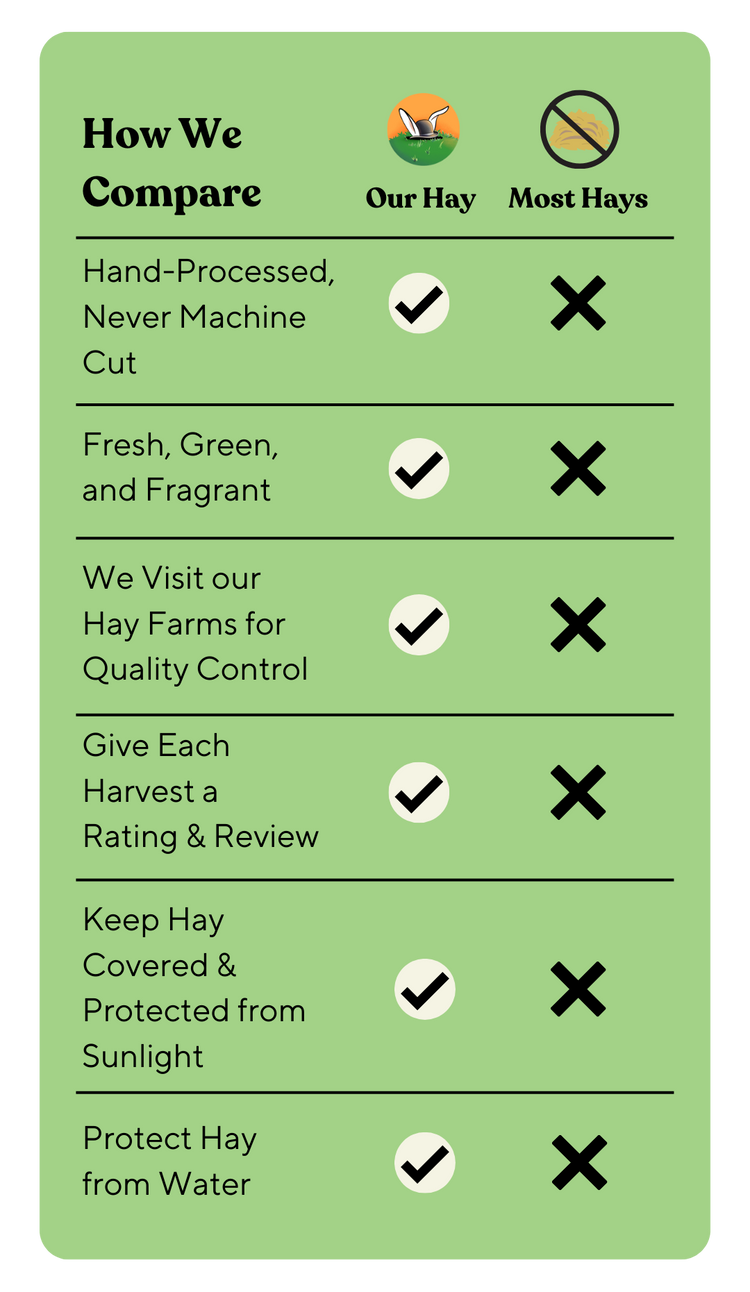Ultra Premium Oat Hay

-
Most orders are shipped from our Warehouse the Next Business Day. In an effort to ensure your product comes as quickly as possible, your product may arrive in a brown box rather than the colored box shown in the image.

Tired of wasting time picking through bad hay just to find the bits your rabbit, guinea pig, or chinchilla will actually eat?
- We visually inspect and hand-pack every package of hay to ensure that you get fresh, green, fragrant hay of the highest quality.
- Your hay is always hand-processed, never machine-cut, creating nice long strands and less small pieces.
- You’ll no longer have to worry about your small pet suffering from irritated eyes or sneezing from excessive dust.
- We preserve freshness by bagging all of our hay. This helps keep it from drying out or absorbing unwanted odors.
Recommended Daily Feeding Chart based on your small pet's age and weight:
Age |
Weight |
Recommendation |
| < 3 Weeks | Any | Mother's Milk |
| 3-4 Weeks | Any | Mother's Milk, nibbles of Alfalfa Hay and Alfalfa Pellets** |
| 4-7 Weeks | Any | Mother's Milk, free access to Alfalfa Hay and Alfalfa Pellets** |
| 7 Weeks to 7 Months |
Any | Unlimited Alfalfa Hay, Alfalfa Pellets and/or Alfalfa Cubes**, unlimited access to chew toys |
|
7 Months |
per 6lbs. |
Unlimited Grass Hay (including Timothy, Orchard or Mountain Grass), 1/2 Cup Alfalfa Pellets*, 1-2 Alfalfa Cubes**, unlimited access to chew toys |
| 1 Year+ | per 6lbs. |
Unlimited Grass Hay (including Timothy, Orchard or Mountain Grass), 1/2 Cup Timothy Pellets*, 1-2 Timothy Cubes. Transition pets off Alfalfa products other than small quantities as a treat only**, unlimited access to chew toys |
* Use a standard 8 ounce measuring cup
** Please follow all veterinary recommendations, every small pet is different and may require specific regimens to maintain optimal health
Grass Hay is an important staple in the diet of rabbits, guinea pigs and chinchillas.
- For rabbits 7 months and older and guinea pigs 6 months and older, grass hay should make up 80% of their diet.
- For chinchillas older than a year, grass hay should make up 75% of their diet.
The constant foraging and grazing encouraged by hay helps to keep them physically active and mentally stimulated. It also helps to wear down their teeth while the long strand fiber helps to keep their digestion regular and functioning properly.
As Timothy Hay has a high fiber and low protein and calcium content, it can be fed free-choice to your rabbits, guinea pigs, chinchillas and other small animals, and should be a mainstay of any small herbivore's diet.
Free-choice feeding means that the hay is constantly available, and the animals can balance their own diet without increased risk of weight gain or digestion issues.
U.S. Shipping
- Most orders are shipped directly from our Warehouse the next business day.
- We don't ship out anything on Saturdays, Sundays, or Holidays.
- In the Continental U.S., shipping is free to those located West of the Mississippi River.
- In the Continental U.S., shipping has a small fee to those located East of the Mississippi River.
- Your order will arrive within 2 to 7 business days once shipped.
- We never count the weight of packaging in our product, if you order a 10 pound bag you'll receive 10 pounds of hay!
International Shipping
We do ship international, but depending on where you are located there may be an additional fee* on top of the shipping cost that your country will require upon the hay arriving. This is not something that we can pay for you, so please keep this in mind when you order from us!
*Depending on your country, the additional fee required may be a customs fee, a duties fee, or both. To research your particular country please visit this website: https://www.myus.com/countries/
To see if we can ship to your country and if so, what the process is please click here to read.
Satisfaction Guaranteed
All our products come with a 30-Day Money Back Guarantee, just contact us and we'll make it right.
Just give us a call at 530-763-6900 or send us an email at support@rabbitholehay.com.


Annual Harvest Report & Fresh From The Hopper - How's The Hay Looking?
Small Pet's Guide to Hay Quality

Not All Hays Are Stored & Packaged Equally



Small Pet Owners Ask
Best Way To Introduce This Hay Into Their Diet?
How Much Hay Should I Feed My Small Pet?
Daily Feeding Recommendations?
What’s The Best Way To Store Hay?
What Makes Oat Hay Unique to Other Hays?
What's The Difference Between All Your Hays?
Are You Monitoring RHDV2? Is Your Hay Affected?


















